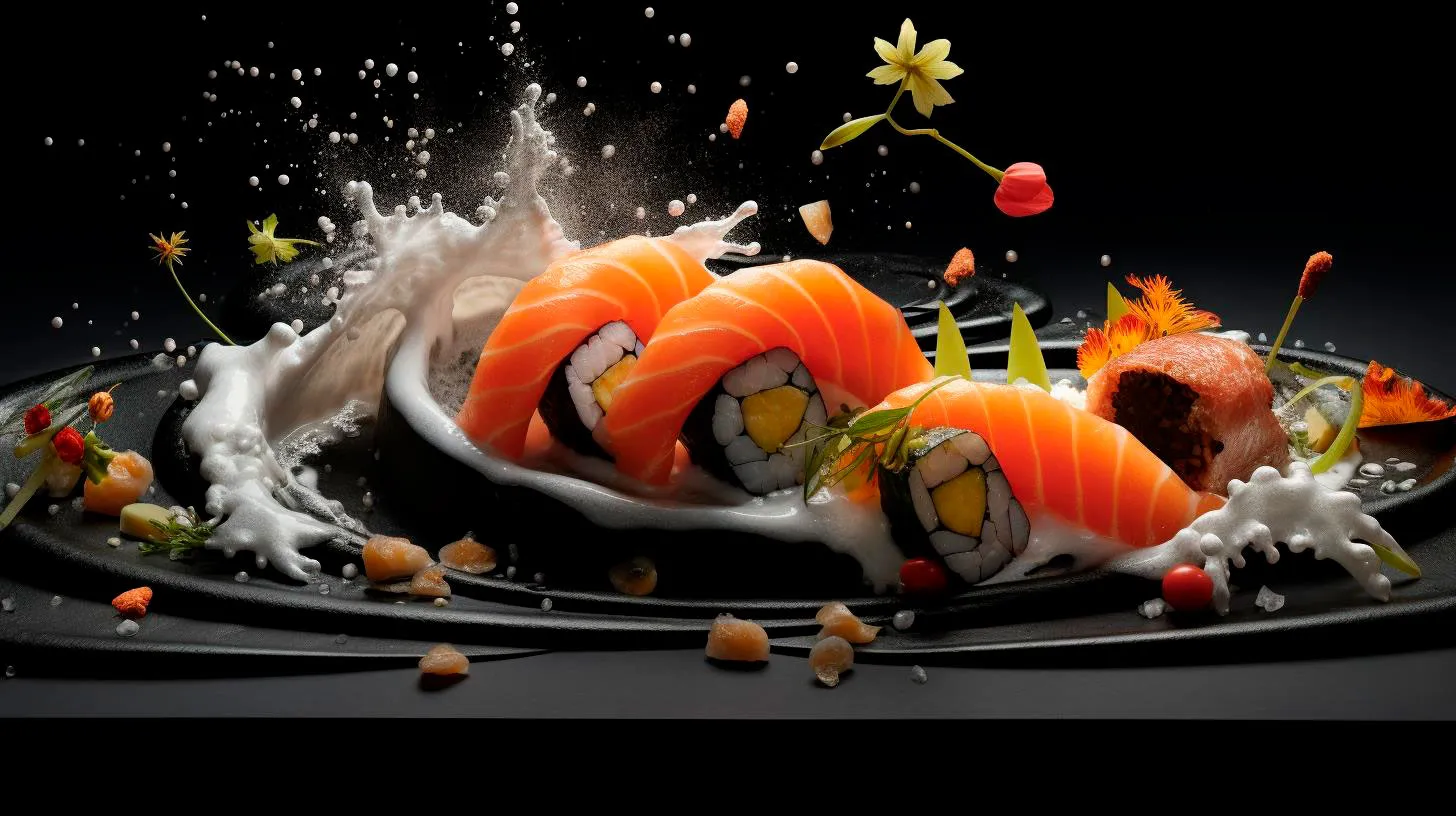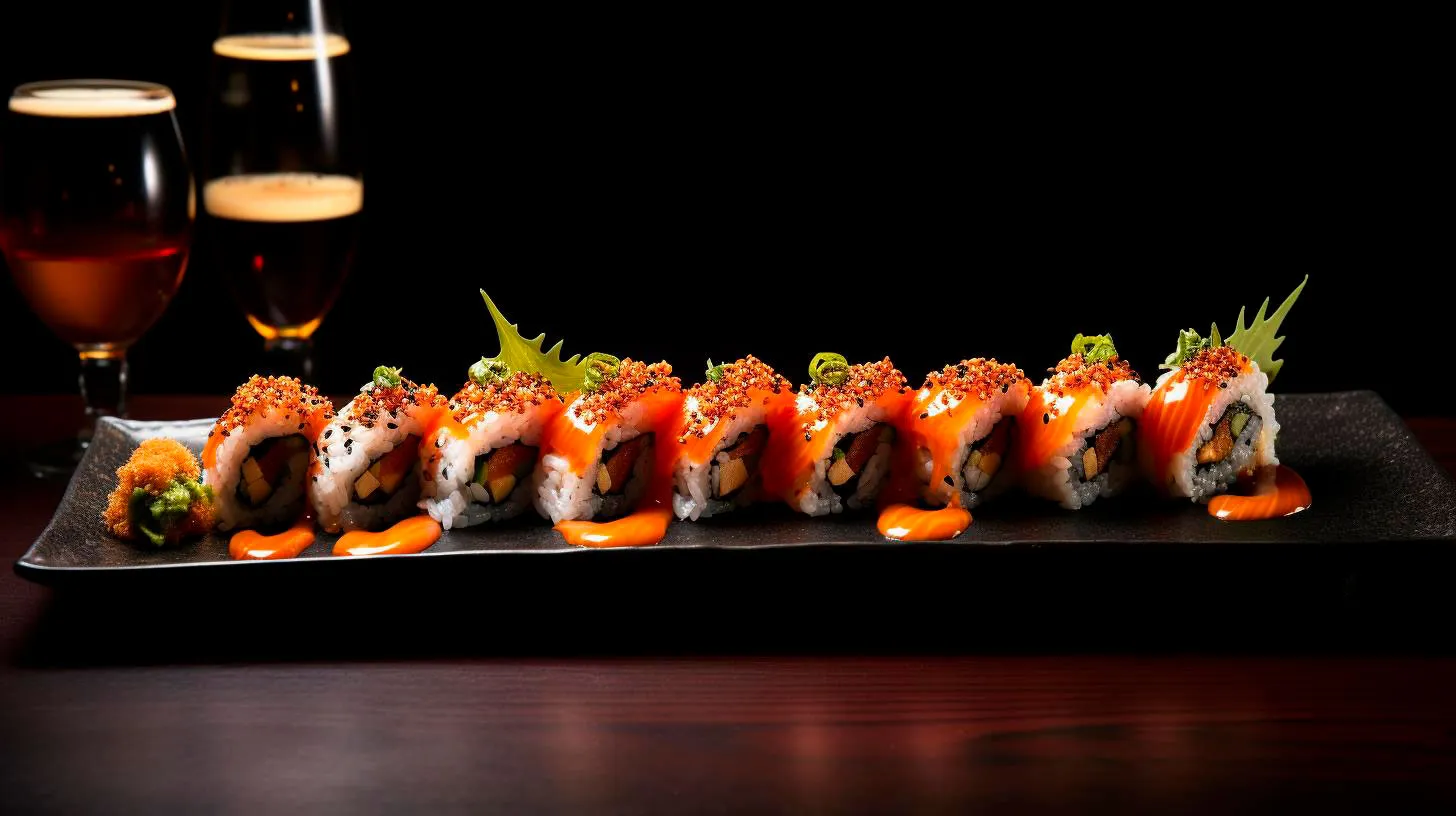Sourcing Sustainable Seafood for a Safer Sushi Experience
In this article, we will explore the importance of sourcing sustainable seafood for a safer and more ethical sushi experience.
The Importance of Sustainable Seafood
Sustainable seafood is harvested or farmed in a way that minimizes harm to the environment and ensures the long-term viability of fish populations. Choosing sustainable seafood options is vital for several reasons:
- Preserving Marine Ecosystems: Overfishing and destructive fishing practices can lead to the depletion of fish stocks, causing imbalances in marine ecosystems. Sustainable fishing methods protect biodiversity and habitats.
- Protecting Endangered Species: Many species of fish have been overexploited or pushed to the brink of extinction due to unsustainable fishing practices. By choosing sustainable seafood, you help conserve these vulnerable species.
- Supporting Local Economies: Sustainable seafood practices also benefit local fishing communities by promoting fair trade and ensuring economic stability.
- Ensuring Food Safety: Sustainable seafood is often sourced from well-managed fisheries or farms that prioritize quality and safety. By consuming sustainable seafood, you reduce the risk of exposure to contaminants.
How to Identify Sustainable Seafood
Identifying sustainable seafood options requires some research and understanding. Thankfully, various organizations and certifications help consumers make informed decisions. Look for the following labels when choosing seafood for your sushi:
- Marine Stewardship Council (MSC) Certified: The MSC mark ensures that the fish is sourced from sustainable fisheries and has passed stringent environmental criteria.
- Aquaculture Stewardship Council (ASC) Certified: This certification guarantees that farmed fish have been produced responsibly, reducing negative environmental impacts.
- Seafood Watch: Seafood Watch, developed by Monterey Bay Aquarium, provides a comprehensive seafood guide classifying seafood options as “Best Choices,” “Good Alternatives,” or “Avoid.”
Additionally, it is helpful to know which varieties of fish are more sustainable. Some examples include Pacific albacore tuna, Arctic char, and rainbow trout. By choosing these sustainable alternatives over less sustainable options like bluefin tuna or farmed salmon, you contribute to a healthier marine environment.
The Future of Sustainable Seafood
The demand for sustainable seafood has been growing steadily as consumers become more environmentally conscious. To meet this demand, the seafood industry is exploring innovative solutions:
- Fisheries Improvement Projects (FIPs): FIPs aim to improve fishing practices and guide fisheries towards sustainability. Supporting companies engaged in FIPs can drive positive change in the industry.
- Agroecological Aquaculture: This approach combines aquaculture with ecological farming principles to create sustainable and environmentally friendly fish farms.
- Traceability and Transparency: Advancements in technology allow consumers to trace the journey of their seafood from ocean to plate, ensuring that it comes from sustainable sources.
Key Takeaways
When indulging in sushi, sourcing sustainable seafood is essential for environmental preservation, food safety, and supporting local communities. Here are the key takeaways to remember:
- Choosing sustainable seafood helps protect marine ecosystems and endangered species.
- Look for certifications like MSC and ASC when purchasing seafood for your sushi.
- Consult resources like Seafood Watch to identify the most sustainable options.
- Consider sustainable fish alternatives to promote a healthier marine environment.
- Support initiatives like FIPs and agroecological aquaculture to drive positive change in the seafood industry.
- Embrace traceability and transparency to ensure seafood comes from sustainable sources.
Remember, by making responsible choices, you can enjoy your sushi guilt-free, knowing that you are contributing to the well-being of our oceans.
How Sushi Restaurants Maintain Hygiene Standards Amidst Rising Concerns
In this article, we will explore the measures that sushi restaurants employ to ensure hygiene and safety for their customers.
Training and Certification of Staff
One of the crucial steps that sushi restaurants take to maintain hygiene standards is by investing in staff training and certification. It is vital for all sushi chefs and kitchen staff to undergo proper training on food handling, preparation, and sanitation practices. By staying up-to-date with the latest industry standards, restaurant staff can effectively minimize the risk of contamination and foodborne illnesses.
- Regular staff training sessions are conducted to keep them informed about the best practices in food safety and hygiene.
- Certification programs, such as the ServSafe food safety training, provide a standardized curriculum for restaurant staff.
- Statistically, restaurants with certified staff have a lower rate of foodborne illnesses.
Strict Quality Control of Ingredients
The quality and freshness of ingredients used in sushi preparation are paramount to ensure food safety. Sushi restaurants prioritize sourcing their ingredients from trusted suppliers who adhere to strict quality control measures. This includes maintaining the proper temperature during transportation and storage, as well as regular inspections to ensure the ingredients meet the required standards.
- Thoroughly inspecting fish and other seafood for freshness and quality before accepting them for use in sushi preparation.
- Sourcing ingredients from reputable suppliers who follow industry best practices for handling and storage.
- Adhering to local regulations and guidelines for seafood sourcing to prevent any health risks.
Routine Cleaning and Disinfection
Cleanliness is a top priority for sushi restaurants to maintain their hygiene standards. Regular cleaning and disinfection of all food preparation areas, utensils, and equipment plays a vital role in preventing cross-contamination and the spread of harmful bacteria.
- Implementing a strict cleaning schedule for all kitchen areas and utensils.
- Using food-grade sanitizers to ensure the removal of any potential contaminants.
- Statistically, restaurants that follow rigorous cleaning routines have a higher customer satisfaction rate.
Safe Food Handling Practices
Proper food handling practices are essential in sushi restaurants to prevent contamination and the growth of harmful bacteria. Sushi chefs and kitchen staff must follow strict guidelines to ensure the safe preparation and storage of food.
- Washing hands thoroughly and frequently during food preparation.
- Using separate cutting boards and utensils for raw and cooked ingredients to prevent cross-contamination.
- Storing food at appropriate temperatures to inhibit bacterial growth.
Regular Health Inspections
Sushi restaurants often undergo regular health inspections to ensure compliance with food safety regulations. These inspections are conducted by local health departments to evaluate the restaurant’s cleanliness, proper handling of ingredients, and adherence to hygiene standards.
- Promptly addressing any violations identified during health inspections.
- Showing the restaurant’s commitment to providing safe and hygienic dining experiences.
- Statistically, restaurants with positive health inspection results tend to attract more customers.
Key Takeaways
Ensuring hygiene and food safety is of utmost importance for sushi restaurants. By investing in staff training, maintaining strict quality control of ingredients, implementing routine cleaning and disinfection practices, following safe food handling practices, and undergoing regular health inspections, sushi restaurants can maintain high hygiene standards and provide their customers with a safe dining experience. So the next time you crave sushi, you can have peace of mind knowing that the restaurant prioritizes your health and safety.
Are Raw Fish and Foodborne Illnesses Linked?
In this article, we will explore whether raw fish and foodborne illnesses are linked and shed light on important facts surrounding this topic.
The Appeal of Raw Fish
Raw fish dishes, such as sushi and sashimi, have been traditionally enjoyed in Japan for centuries. But in recent years, this delicacy has become highly sought after globally, with sushi restaurants popping up in almost every major city.
- Freshness: Raw fish offers a unique experience of taste and texture that cannot be replicated when the fish is cooked. The delicate flavors and soft texture are highly appealing to many food enthusiasts.
- Culinary Variety: Raw fish is remarkably versatile, as it can be prepared and served in a variety of ways, including sushi rolls, nigiri, and sashimi. This diversity adds to its allure.
- Health Benefits: Fish is an excellent source of nutrients, including omega-3 fatty acids, high-quality proteins, vitamins, and minerals. Consumption of raw fish allows for maximum retention of these nutrients.
The Risks of Consuming Raw Fish
While raw fish is celebrated for its unique qualities and health benefits, it is essential to be aware of the potential risks associated with consuming it.
- Bacterial Contamination: Raw fish, like any other food, can be susceptible to bacterial contamination. Bacteria such as Salmonella, Vibrio, and Listeria have been known to cause foodborne illnesses when present in raw or undercooked fish.
- Parasitic Infections: Some species of fish carry parasites, including Anisakis and Diphyllobothrium, which can cause infections in humans. These parasites are more likely to be present in raw fish than cooked fish.
- Cross-Contamination: The preparation of raw fish requires meticulous attention to hygiene. Cross-contamination can occur if the same knives and cutting boards are used for raw fish and other ingredients without proper cleaning in between.
Ensuring the Safety of Raw Fish
Despite the potential risks associated with consuming raw fish, there are measures that can be taken to ensure its safety.
- Source High-Quality Fish: Choose reputable suppliers or markets known for providing fresh and high-quality fish. Ensuring the fish has been handled properly reduces the risk of contamination.
- Freezing: Freezing fish at temperatures below -20°C (-4°F) for a specific period helps kill parasites. The FDA recommends freezing fish for at least 7 days to eliminate potential risks.
- Hygiene Practices: Practicing good hygiene is crucial during the preparation of raw fish. This includes using separate knives and cutting boards for different ingredients, regularly washing hands, and maintaining clean food preparation surfaces.
- Education and Training: Chefs and sushi chefs should undergo proper training and education regarding food safety to minimize the risks associated with handling raw fish.
Key Takeaways
Consuming raw fish can be a delightful culinary experience, but it is crucial to be aware of the potential risks involved. Here are the key takeaways:
- Raw fish provides unique flavors and culinary variety, making it a popular choice among food enthusiasts.
- However, raw fish can carry bacteria and parasites, which may lead to foodborne illnesses if not handled properly.
- Ensure you source high-quality fish and take necessary precautions, such as freezing, to minimize the risk of contamination and parasitic infections.
- Practicing good hygiene during the preparation of raw fish is of utmost importance, including using separate equipment and maintaining clean surfaces.
- Proper education and training for chefs are essential to ensure the safe handling of raw fish and minimize risks associated with consumption.
By being knowledgeable and conscious of food safety practices, you can minimize the potential risks and enjoy raw fish dishes with peace of mind.
Handling Sushi Rice Properly: A Must-Know Guide
The Importance of Properly Handling Sushi Rice
Sushi rice is the foundation of every sushi roll. Its perfect texture, sticky consistency, and subtle flavors are what make sushi so irresistible. When sushi rice is handled properly, it enhances the overall taste and experience. Improper handling can result in rice that is too dry, too sticky, or lacks the necessary balance of flavors.
Key Takeaways:
- Properly handling sushi rice is crucial for achieving the perfect taste and texture of sushi.
- Improper handling can lead to rice that is too dry, too sticky, or lacking flavor balance.
The Step-by-Step Guide to Handling Sushi Rice
Step 1: Choosing the Right Rice
It all starts with selecting the right type of rice. Look for short-grained rice specifically meant for sushi. Popular options include Japanese Calrose rice or Koshihikari rice. These varieties have the ideal balance of starch content, stickiness, and flavor.
Step 2: Washing the Rice
Before cooking the rice, it’s important to wash off any excess starch. Place the desired amount of rice in a strainer and rinse it under cold running water until the water runs clear. This removes any surface impurities and prevents the rice from becoming too sticky.
Step 3: Cooking the Rice
Once washed, transfer the rice to a rice cooker or a pot. Add the appropriate amount of water, usually a 1:1 ratio of rice to water. Cook the rice according to the manufacturer’s instructions or bring the pot to a boil and then reduce the heat to a simmer. Let the rice cook for about 15-20 minutes or until all the water is absorbed and the rice is tender.
Step 4: Seasoning the Rice
The secret to perfectly seasoned sushi rice lies in the proper combination of rice vinegar, sugar, and salt. In a small saucepan, heat vinegar, sugar, and salt until dissolved. Once the rice is cooked, transfer it to a wooden or non-metallic bowl and gently pour the seasoned vinegar over it. Use a wooden spatula to fold the vinegar into the rice, making sure every grain is coated evenly. Allow the rice to cool to room temperature.
Step 5: The Art of Mixing
Using a cutting and folding motion will ensure the seasoning is well distributed throughout the rice. Be careful not to overmix, as it can result in a mushy texture. The consistency should be sticky enough to hold its shape when formed into sushi rolls.
Step 6: Proper Storage
When not using sushi rice immediately, cover it with a damp cloth or plastic wrap to prevent it from drying out. Storing it in the refrigerator can affect the texture, so it’s best to use it within a few hours. Make sure the rice is at room temperature before using it for sushi.
Advantages of Properly Handling Sushi Rice:
- Enhances the taste and texture of sushi rolls.
- Creates a well-balanced flavor profile.
- Helps sushi rice hold its shape when forming sushi rolls.
- Prevents rice from becoming overly sticky or dry.
By following these steps, you’ll be able to handle sushi rice like a true sushi chef. Remember, practice makes perfect! As you continue to refine your skills, you’ll discover your own personal touch and nuances when it comes to handling sushi rice.
So, go ahead and experiment with different flavor combinations and creative sushi recipes, now that you have the know-how to handle sushi rice properly. Enjoy the satisfaction of creating your own delicious sushi at home and impressing your friends and family with your culinary skills!



